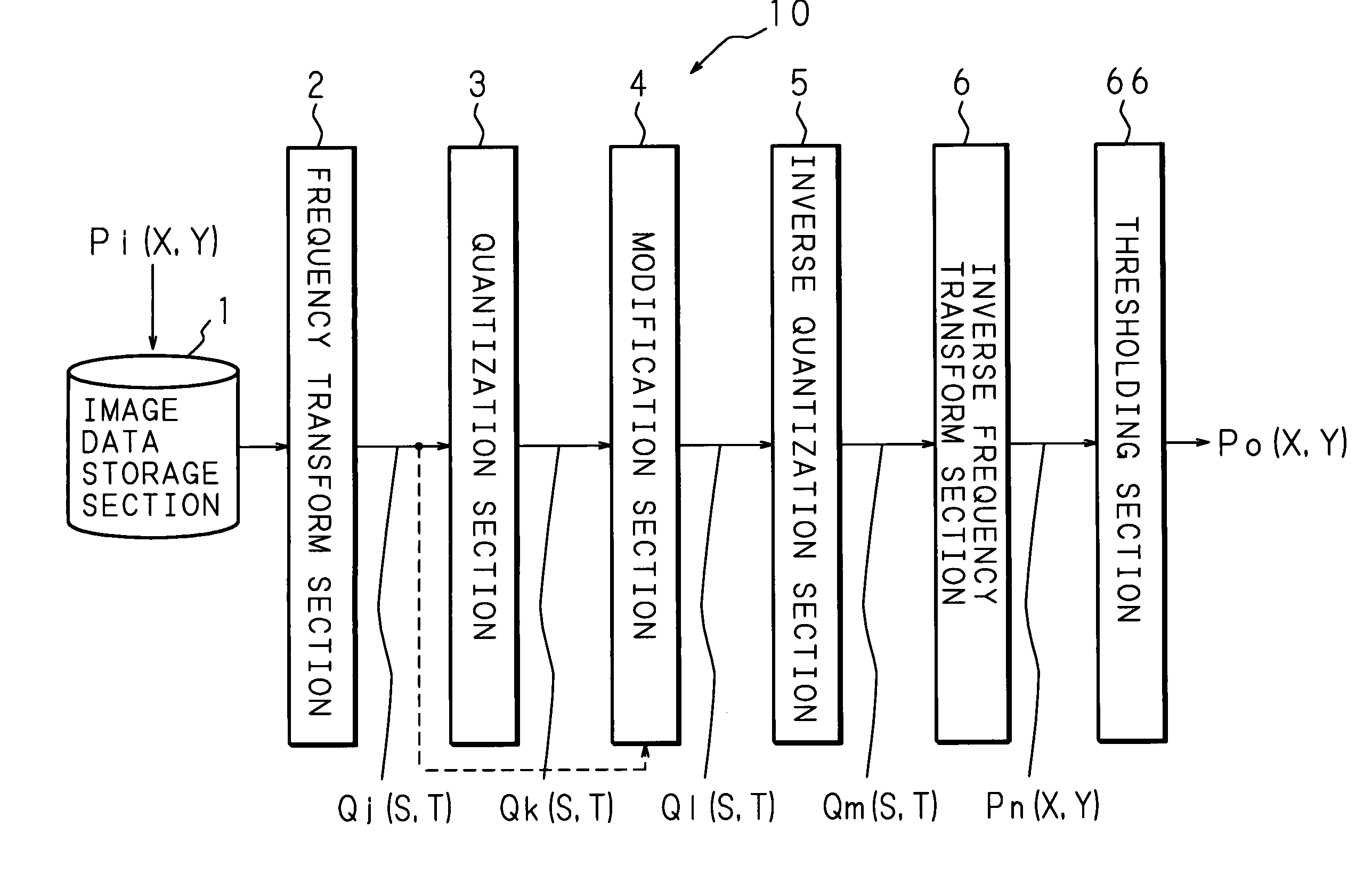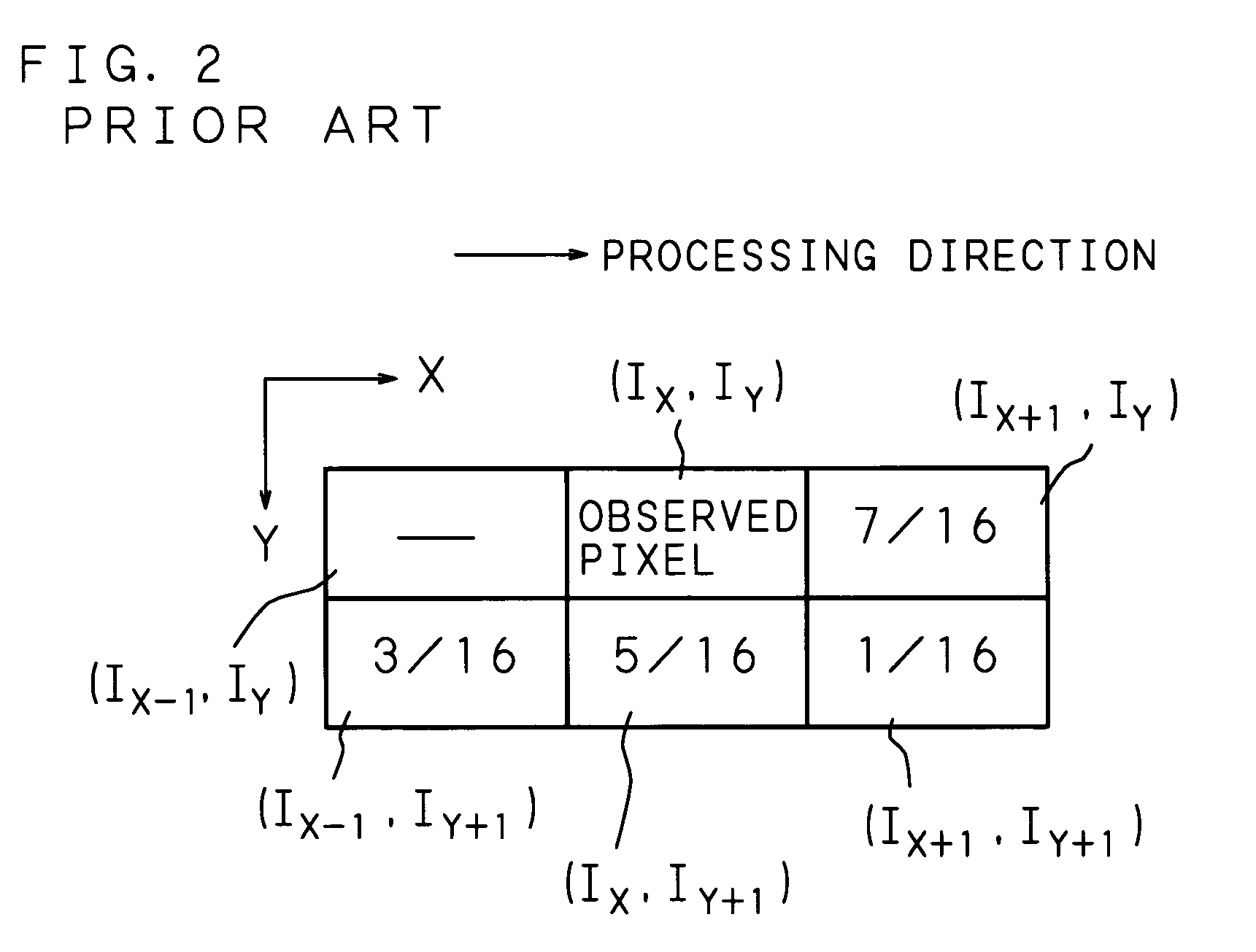Image processing method, image processor, image forming apparatus and memory product
a technology of image processing and memory products, applied in image enhancement, instruments, computing, etc., can solve problems such as non-change of levels, tone gaps, repetition of textures, etc., to reduce the amount of frequency components to be changed, reduce the number of gray levels in inverse-transformed image data, and reduce the number of gray levels
- Summary
- Abstract
- Description
- Claims
- Application Information
AI Technical Summary
Benefits of technology
Problems solved by technology
Method used
Image
Examples
embodiment 1
[0093]FIG. 3 is a block diagram showing an example of the structure of a grayscale reproduction processor (image processor) 10 of the present invention. The grayscale reproduction processor 10 is an image processor for generating output image data Po (X, Y) by reducing the number of gray levels (for example, 256 gray levels) of input image data Pi (X, Y) to two levels or four levels. Here, the input image data Pi (X, Y) is pixel data at the Xth pixel position on the Yth line of image data composed of pixels arranged in a two-dimensional matrix of the X-direction (right direction) and Y direction (down direction), and a large number of input image data Pi (X, Y) constitute a two-dimensional image.
[0094]The grayscale reproduction processor 10 comprises: an image data storage section 1 for storing input image data Pi (X, Y); a frequency transform section 2 for transforming the input image data Pi (X, Y) into spatial frequency components Qj (S, T); a quantization section 3 for quantizin...
embodiment 2
[0111]FIG. 8 is a block diagram showing an example of the structure of a grayscale reproduction processor (image processor) 11 of the present invention. Like the grayscale reproduction processor 10 of Embodiment 1 shown in FIG. 3, the grayscale reproduction processor 11 comprises: an image data storage section 1; a frequency transform section 2; a quantization section 3; a modification section 4; an inverse quantization section 5; an inverse frequency transform section 6; and a thresholding section 66. However, the quantization section 3 and modification section 4 are connected in the reverse order to that of Embodiment 1 (FIG. 3).
[0112]In Embodiment 2, the modification section 4 changes the modification region of the spatial frequency components (DCT coefficients) Qj (S, T) transformed in the frequency transform section 2. The modification process is almost the same as that in Embodiment 1, but, in Embodiment 2, since quantization has not been performed by the quantization section ...
embodiment 3
[0114]FIG. 9 is a block diagram showing an example of the structure of a grayscale reproduction processor (image processor) 12 of the present invention. Between the quantization section 3 and modification section 4 of the grayscale reproduction processor 10 of Embodiment 1 shown in FIG. 3, the grayscale reproduction processor 12 further comprises a DC component determining section 7 for determining the magnitude of the DC component of the spatial frequency components (DCT coefficients) Qk (S, T) quantized in the quantization section 3 and controlling the number of 0s, or 1s and −1s changed by the modification section 4, based on the magnitude of the DC component. Here, the number of Is and the number of −1s are the same, and, for example, if the number of 1s and −1s is 2, then the number of 1s is 2 and the number of −1s is also 2. For instance, if the number of 1s and −1s to be changed is 2, then two DCT coefficients in the modification region are changed to 1, and other two DCT coe...
PUM
 Login to View More
Login to View More Abstract
Description
Claims
Application Information
 Login to View More
Login to View More - R&D
- Intellectual Property
- Life Sciences
- Materials
- Tech Scout
- Unparalleled Data Quality
- Higher Quality Content
- 60% Fewer Hallucinations
Browse by: Latest US Patents, China's latest patents, Technical Efficacy Thesaurus, Application Domain, Technology Topic, Popular Technical Reports.
© 2025 PatSnap. All rights reserved.Legal|Privacy policy|Modern Slavery Act Transparency Statement|Sitemap|About US| Contact US: help@patsnap.com



